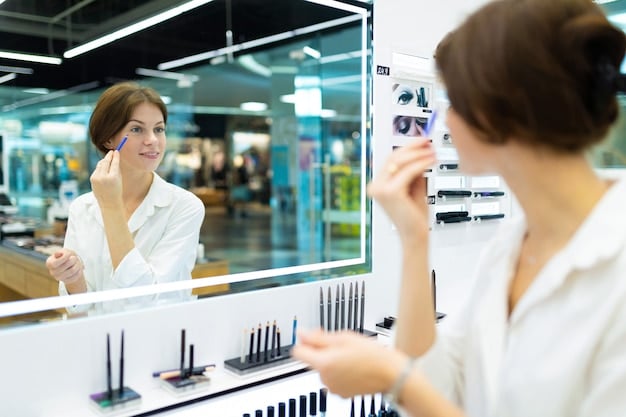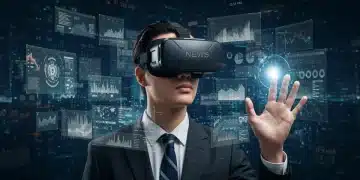Augmented Reality Shopping: Transforming the US Retail Experience

Augmented reality (AR) shopping is revolutionizing the retail experience in the US by overlaying digital information onto the real world, enhancing product visualization and customer engagement, and driving sales through immersive experiences.
The way Americans shop is rapidly changing, and augmented reality (AR) shopping is at the forefront of this transformation. Consumer tech is no longer just about convenience; it’s about creating richer, more engaging experiences that blur the lines between the physical and digital worlds.
The Rise of Augmented Reality in US Retail
Augmented reality (AR) is rapidly moving from a futuristic concept to a practical tool reshaping the retail industry in the United States. By blending digital content with the real world, AR offers consumers innovative ways to interact with products before making a purchase.
This technology enhances the shopping experience, providing valuable information and immersive visuals that traditional methods cannot match. Let’s delve deeper into how AR is transforming the US retail landscape.
Enhanced Product Visualization
One of the biggest advantages of AR in retail is its ability to provide enhanced product visualization. Customers can use their smartphones or tablets to overlay digital images of products onto their physical surroundings. For example, a shopper can use an AR app to virtually place a piece of furniture in their living room to see how it fits with their existing decor. This level of visualization reduces the uncertainty associated with online purchases and can lead to higher customer satisfaction.
Immersive Shopping Experiences
AR also enables retailers to create immersive shopping experiences that capture the imagination of their customers. For instance, cosmetic brands use AR apps that allow users to virtually “try on” different shades of makeup. These interactive experiences not only entertain consumers but also empower them to make more informed purchasing decisions. AR can also deliver gamified experiences to incentivize purchases.
- Virtual Try-Ons: Allowing customers to virtually try on clothing, makeup, or accessories.
- Product Placement: Enabling customers to see how furniture or appliances fit in their homes.
- Interactive Catalogs: Creating catalogs that come to life with interactive AR elements and additional information.
- Gamified Shopping: Introducing game-like elements to the shopping experience to increase engagement and drive sales.
The use of AR in US retail is still in its early stages, but its potential is immense. As the technology becomes more accessible and affordable, retailers are expected to integrate AR into more aspects of the shopping experience. For consumers, this means more engaging, informative, and satisfying shopping journeys.

How AR Enhances the Customer Journey in US Retail
AR is not only changing how retailers present their products, but it is also fundamentally altering the customer journey. By integrating AR into various stages of the buying process, retailers can provide personalized, convenient, and engaging experiences that build customer loyalty.
From initial product discovery to post-purchase support, AR is enhancing every touchpoint in the customer journey. Let’s examine the specific ways AR is making a difference.
Product Discovery and Awareness
AR is transforming the way consumers discover and learn about new products. Retailers can use AR to create virtual showrooms or interactive displays that allow customers to explore products in a more engaging way than traditional advertising. For example, a potential car buyer could use an AR app to view a new model in their driveway, interact with its features, and customize its color and options—all from the comfort of their home. This enhances product awareness and generates excitement.
In-Store Navigation and Information
AR can also improve the in-store shopping experience by providing wayfinding assistance and additional product information. Shoppers can use AR apps to navigate through a store, locate specific items, and access detailed product specifications, customer reviews, and promotional offers. This enhances convenience and helps shoppers make informed decisions. Some retailers are also using AR to provide personalized recommendations based on a customer’s shopping history and preferences.
By strategically integrating AR into the customer journey, retailers can drive sales, build brand loyalty, and differentiate themselves in an increasingly competitive market. Here are some of the touchpoints that retailers are focusing on:
- Personalized Recommendations: Using AR to suggest products based on customer preferences.
- Virtual Assistants: Implementing AR-powered virtual assistants to provide real-time support and guidance.
- Post-Purchase Support: Providing AR-based tutorials and guides for product setup and maintenance.
- Loyalty Programs: Integrating AR into loyalty programs to offer exclusive experiences and rewards.
The integration of AR into retail is revolutionizing the customer journey by offering a more interactive, informative, and personalized shopping experience. As AR technology continues to evolve, its impact on the customer journey will only increase.
The Impact of AR on Sales and Marketing in the US
The adoption of AR in retail isn’t just about enhancing the customer experience—it’s also significantly impacting sales and marketing strategies. Retailers are leveraging the immersive nature of AR to drive engagement, increase conversions, and build stronger brand connections.
The effective use of AR tools is creating new opportunities for businesses to reach and resonate with their target audiences. Let’s explore the specific ways AR is influencing sales and marketing within the US market.
Boosting Engagement and Conversions
AR can significantly boost customer engagement and improve conversion rates by providing a more interactive and compelling shopping experience. When customers can virtually try products or see how they fit into their lives, they are more likely to make a purchase. For example, eyewear retailers use AR apps that allow customers to virtually try on different frames, increasing the likelihood of a sale. These engaging experiences lead to higher conversion rates and increased revenue.
Creating Memorable Brand Experiences
AR enables retailers to create memorable brand experiences that resonate with customers. By offering unique and immersive interactions, retailers can strengthen brand connections and foster loyalty. For instance, a furniture store could offer an AR experience that allows customers to design their own virtual room using the store’s products. These personalized experiences create lasting impressions and build customer advocacy. AR powered games and interactive experiences help create brand recall.

Marketing strategies enhanced by AR increase customer engagement and lead to better brand recognition and loyalty. Some strategic applications include:
- AR-Powered Advertising: Offering interactive AR ads that allow customers to explore products in a virtual environment.
- Social Media Integration: Encouraging customers to share their AR experiences on social media platforms.
- Influencer Collaborations: Partnering with influencers to showcase AR experiences to a wider audience.
- Event Marketing: Using AR to create interactive experiences at trade shows and events.
The strategic integration of AR into sales and marketing efforts allows businesses to create deeper connections with their customers, driving conversions and building brand loyalty. As AR technology evolves, its role in sales and marketing will continue to expand.
Challenges and Opportunities for AR in US Retail
While the potential of AR in retail is immense, there are several challenges hindering its widespread adoption. Overcoming these obstacles will be crucial for retailers looking to leverage the full power of AR in the US market.
However, with these challenges come significant opportunities for innovation and growth. Let’s discuss some of the key hurdles and prospects facing AR in the US retail sector.
Technological Limitations
One of the main challenges is the still evolving nature of the technology. AR experiences require accurate and stable tracking, realistic rendering, and seamless integration with mobile devices. Technical glitches, poor performance, and compatibility issues can easily frustrate users and undermine the overall experience. Additionally, the need for high-quality 3D models and detailed product information can be time-consuming and expensive for retailers. As technology continues to advance, these limitations will gradually diminish.
Consumer Adoption and Awareness
Another challenge is the need for increased consumer adoption and awareness. While many consumers are curious about AR, they may not be familiar with how to use it or understand its potential benefits. Retailers need to educate consumers about the value of AR and create experiences that are easy to access and engaging to use. Simple, intuitive interfaces and clear instructions are essential for encouraging widespread adoption. Targeted marketing campaigns and in-store demonstrations can also help drive awareness and adoption among US consumers.
Despite the challenges, there are significant opportunities for those ready to adopt. Here are some areas where opportunity exists:
- AR in Small Businesses: Helping small retailers leverage simple and affordable AR solutions to enhance customer experience.
- AR-Enhanced Customer Loyalty: Using AR to offer exclusive rewards, personalized offers, and unique experiences through loyalty programs.
- AR Analytics: Helping retailers analyze user behavior within AR experiences to optimize product offerings and marketing strategies.
- AR-Powered Accessibility: Developing AR tools for inclusive shopping experiences.
Addressing the technological limitations and fostering consumer adoption are essential steps for unlocking the full potential of AR in the US retail market. Retailers who effectively navigate these challenges will be well-positioned to reap the rewards of this transformative technology.
Future Trends in Augmented Reality Shopping in the US
As AR technology continues to evolve, several key trends are expected to shape the future of augmented reality shopping in the US. Understanding these trends will help retailers prepare for the next wave of innovation and maintain a competitive edge.
These trends are poised to reshape consumer expectations and drive even greater adoption of AR in retail. Let’s take a closer look at the emerging areas that will redefine the AR landscape in the US.
Integration with Artificial Intelligence (AI)
One of the most promising trends is the integration of AR with Artificial Intelligence (AI). By combining these technologies, retailers can create more personalized and intelligent shopping experiences. AI can analyze customer data to provide tailored product recommendations, predict shopping behavior, and optimize AR content in real-time. For example, an AI-powered AR app could suggest clothing items that complement a customer’s existing wardrobe or recommend furniture that fits their home’s style and layout. This level of personalization will drive engagement and increase sales.
AR Cloud and Persistent AR Experiences
The rise of the AR Cloud will enable persistent AR experiences that remain anchored to specific locations in the real world. This means that AR content can be shared and accessed by multiple users over time, creating a more immersive and collaborative shopping environment. For instance, a store could create a virtual treasure hunt that leads customers to different products, or a restaurant could offer AR-enhanced menus that come to life when viewed through a smartphone. Persistent AR experiences will transform physical spaces into interactive environments, blurring the lines between the real and virtual worlds.
The future holds many use cases and trends, here are some:
- Remote Shopping Assistants: AR will provide remote interactions that will bridge the gap of in-person assistance
- Shopping for groceries: AR applications can give detailed information about the foods that you intend to buy
- Sizing issues: The use of implemented AR tech can give realistic expectations of sizing issues that plague shopping.
- EcoFriendly: Information about where to buy fairly sourced or other eco-friendly products can be available in the technology.
By embracing these developments, retailers within the US can stay ahead of the curve and create truly innovative shopping experiences that captivate and delight US consumers.
Examples of Successful AR Implementation in US Retail
Several US retailers have already begun implementing AR technologies with impressive results. Examining these success stories offers valuable insights for those considering adopting AR solutions.
These examples demonstrate the diverse applications and benefits of integrating augmented reality into the retail landscape. Let’s explore some notable case studies that highlight the transformative power of AR.
IKEA Place
IKEA Place is a well-known example of successful AR implementation in the furniture retail sector. The app allows customers to virtually place IKEA furniture items in their homes using their smartphones or tablets. This enables them to visualize how a particular piece of furniture will look in their space before making a purchase. IKEA Place has been praised for its ease of use and accuracy, and it has significantly increased customer confidence in online furniture purchases.
Sephora Virtual Artist
Sephora Virtual Artist is an AR app that allows customers to virtually try on different makeup products using their smartphones. The app offers a wide range of features, including virtual lipstick, eyeshadow, and foundation try-ons, as well as tutorials and beauty tips. Sephora Virtual Artist has been credited with driving increased sales and engagement, as well as improving customer satisfaction and loyalty.
Retailers within the US are finding that AR technology has many solutions.
- Home Depot: Retailers can use AR to improve buyer confidence.
- Warby Parker: Is able to use AR as a virtual assistant that helps the customer select the most appropriate merchandise for their needs.
- Nike: AR is able to offer exclusive promotional deals.
- Target: AR apps can provide real-time wayfinding and increase ease of access for customers.
These successful examples demonstrate that AR can be a valuable tool for US retailers. By providing immersive, engaging, and informative shopping experiences, retailers can drive sales, build customer loyalty, and differentiate themselves in an increasingly competitive market.
| Key Point | Brief Description |
|---|---|
| 📱Enhanced Visualization | AR boosts product visualization and confidence. |
| 🛍️Customer Journey | AR enhances shopping stages for personalization. |
| 🚀Sales Impact | AR can improve revenue through increased engagement. |
| 💡Future Trends | AI integration will drive personalization and sales. |
FAQ
▼
Augmented reality (AR) shopping superimposes computer-generated images onto a user’s view of the real world, providing an enhanced shopping experience. This allows consumers to visualize products in their own environment before purchasing.
▼
AR improves the customer journey by offering virtual try-ons, product placement, and interactive catalogs. It enhances awareness, boosts engagement, and provides personalized shopping experiences leading to higher customer satisfaction.
▼
Challenges include technological limitations, such as tracking accuracy and rendering quality, as well as consumer adoption issues due to lack of awareness and usability problems. Overcoming these challenges is required for widespread use.
▼
Integration of artificial intelligence (AI) allows personalization by predicting needs, AR clouds enable location-based shared experiences, and enhanced virtual reality provide richer online shopping through remote assistance.
▼
Yes, AR can significantly boost customer engagement and improve conversion rates by providing a more interactive and compelling shopping experience. When customers can virtually try products, they are more likely to make a purchase.
Conclusion
Augmented reality shopping is revolutionizing the US retail experience by transforming consumer engagement, boosting sales, and fostering innovation. While certain barriers remain, the integration of AI, the development of the AR Cloud, and increasing adoption signify a promising trajectory. This technology presents unparalleled opportunities for businesses to connect with customers and deliver personalized shopping experiences.





